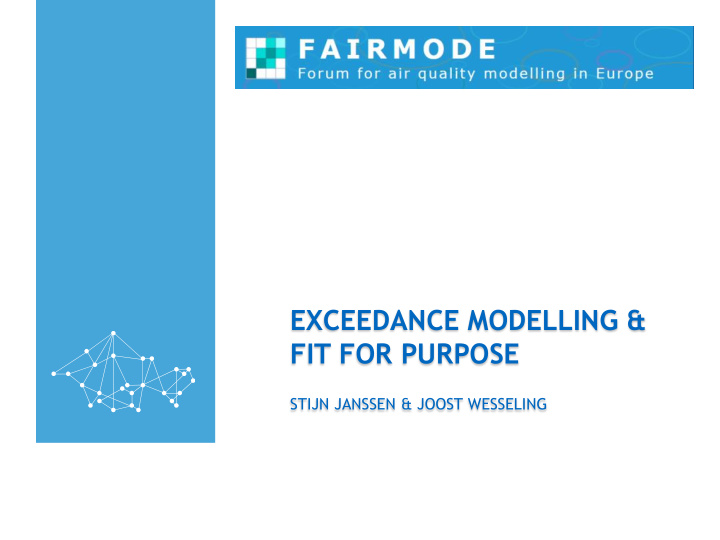



EXCEEDANCE MODELLING & FIT FOR PURPOSE STIJN JANSSEN & JOOST WESSELING
EXCEEDANCE ESTIMATES & THE AQD » Reporting of an exceedance situation according to implementing decision 2011/850/EC » 6. Estimate of the surface area where the level was above the environmental objective » 7. Estimate of the length of road where the level was above the environmental objective » 10. Estimate of the total resident population in the exceedence area 2
FITNESS FOR PURPOSE » No guidance exist on how to estimate these quantities » Models have a role to play in this process but… which are “fit for purpose”? » FAIRMODE should come up with an answer 3
FITNESS FOR PURPOSE » Criteria to assess fitness-for-purpose: » FAIRMODE’s MQO min. quality objective » Spatial variability of the environmental objective min. spatial scale » Temporal scale of the environmental objective min. temporal scale » Additional considerations: » Model type » Data assimilation / data fusion » Output frequency 4
FITNESS FOR PURPOSE – ALREADY COVERED WITHIN FAIRMODE » Criteria to assess fitness-for-purpose: » FAIRMODE’s MQO min. quality objective » Spatial variability of the environmental objective min. spatial scale » Temporal scale of the environmental objective min. temporal scale » Additional considerations: » Model type » Data assimilation / data fusion » Output frequency 5
NO2 MAP OF LONDON AT VARIOUS RESOLUTION 6
NO2 MAP OF FLANDERS REGION AT VARIOUS RESOLUTION 7
NO2 MAP OF VIENNA AT VARIOUS RESOLUTION 8
SPATIAL VARIABILITY » How to define the spatial variability of an environmental objective? » Dedicated measurement campaigns » Modeling exercises » Expert opinion & literature review » … » Spatial variability of the “real world” should eventually define the spatial resolution of the modelling application » Focus on NO 2 and PM 2.5 (PM 10 ) in a first stage 9
QUESTIONS TO THE WORKING GROUP 1. Do you see other elements that define the extent of a model’s fitness-for-purpose with regard to exposure assessment ? 2. Do you agree that assessment/definition of the typical spatial variability is one of the main missing criteria to define fitness- for-purpose within the present FAIRMODE concepts? 3. Do you have any preferences or suggestions on how to define the typical spatial variability for the yearly average environmental criteria for NO 2 and PM 2.5 (first focus)? 4. Can you come up with a proposal for the required spatial resolution for annual averaged NO 2 and PM 2.5 simulations? What kind of information do you base your proposal on? 10
FEEDBACK FROM MATTHEW ROSS-JONES (SE) » I agree that the three elements quality , spatial and temporal scale are the key elements that should be considered. » With regard to spatial scale I wonder if it might be best to split this into two separate elements, spatial resolution and spatial extent ? It is possible to have an appropriate spatial resolution but a spatial extent which is far too limited, or vice-versa. » Whereas the appropriateness of a model’s spatial resolution may vary for different pollutants and averaging times, I think that any criteria for spatial extent could be more general . 11
Recommend
More recommend